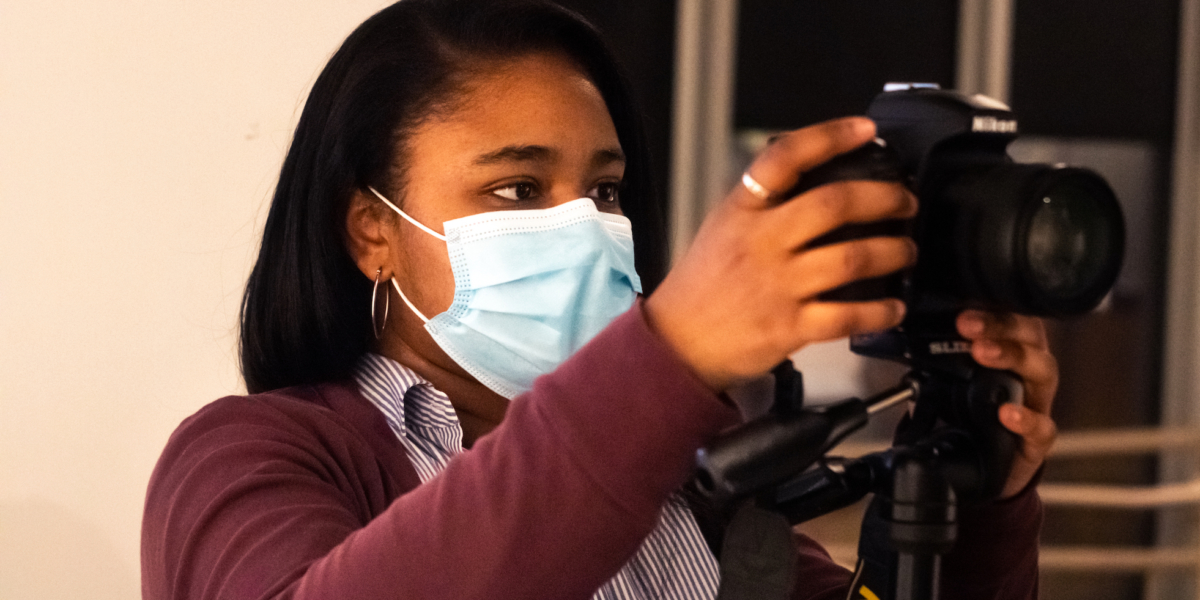
Na’Chelle Morris ’22 documents the Main Gallery’s 2021 Faculty Biennial
Saturday, March 27th, 2021
This is Part II of a series highlighting the hard work and creative input of students who worked behind the scenes to make the 2021 Faculty Biennial a success.
Na’Chelle Morris ’22, the official photographer of PCA&D’s student-run CORE Gallery, was assigned to document the 2021 Faculty Biennial for the Main Gallery. Charged with documenting the artwork, exhibitions, events, and people of the gallery, Morris plays a crucial role in the Gallery’s endeavors. A native of Brookhaven, Pennsylvania, Morris holds an AFA in Photography, with High Honors, from Delaware County Community College, and was inducted into Phi Theta Kappa International Honor Society. Morris was awarded a 2020-2021 UPS Scholarship for her academic achievements. She hopes to be an exhibiting photographer artist after graduating PCA&D with her BFA.
There are many different types of photography specialties: portrait, journalistic, event, fashion, fine art, still-life or product photography, landscape, architecture, astrophotography, and documentary. Gallery Installation shots fall under the documentation category. More than just artwork images, they record the placement and context of objects and works of art as they are displayed in situ. These photos then are used for archival purposes, recording the exhibition for historical purposes, and also are used in exhibit promotions. They’re also helpful visuals for those who are unable to visit the exhibit in person, to help them understand the presentation.
This is the first time you conducted this type of photography. Can you tell us about your experience and how is it different from the other types of photography you have done?
NM: Installation photography is different because it’s a lot more formal. Typically, when I’m taking photographs, there’s a degree of control I am used to having over the situation and the subject matter, and absolute freedom over the way I can compose my subject matter in the frame. There are always typical compositional rules with anything (but, with the freedom of being able to be broken). With installation, you can only get so creative because the purpose is to document the space and the artwork in the best way possible. It’s similar to event photography in a way because the sole purpose of each is to document, but with installation, your subject doesn’t move at all. You kind of just have to take your time and pay attention to details.
What type of photography do you normally do? Do you have a type of photography that you specialize in?
NM: I don’t really specialize in any specific type of photography yet. I’m still figuring out my niche and trying to dip into different categories. However, because I value freedom of composition, I tend to stay in the overall bubble of fine art despite the exploration of different styles. Lately, I’ve really been into editorial pictures, which is something I never thought I would be interested in. However, after seeing a certain photographer’s editorial pictures on Instagram, I ended up appreciating the artistic aspect I’ve never seen in editorial photos before.
What challenges did you encounter with this type of photography? And with this space?
NM: Lighting was definitely a challenge! Figuring out the best ways to compose both the space and the artwork was challenging as well. Like I mentioned before, there’s a formal-ness to installation photographs that I wasn’t used to and had to adapt to!
Why do you think installation photography is so important and why do you think it is so challenging?
NM: I think it’s definitely important! Having work hung in a gallery is a pretty big deal, so capturing that moment is a big deal as well. You want to make sure you can capture the artist’s work and the gallery space well because it’s a significant partnership between the two. However, each space in terms of its setup and lighting is different which can be challenging, and the lighting of artwork can add to the challenge as well. Sometimes the artwork might be really dark, or really bright when lit, so finding a balance in exposure for the two can be difficult.
Did you enjoy working on this project? What did you learn? What was the most memorable experience? What would you do differently? Do you think this was a special opportunity to be tasked with documenting the Faculty Show in the Main Gallery?
NM: I can’t quite say I enjoyed it, but I definitely value the knowledge and experience I gained from this experience! If I were to do anything differently, I definitely would research more about installation photography ahead of time. However, with the guidance of the Gallery Director and Department Chair, I was still able to produce good photos of the space.
Documentation by Na’Chelle Morris ’22
The Faculty Biennial is an important tradition that celebrates faculty members for their dedication to the College’s mission and showcases their creative talents. This year’s rendition of the exhibit features the full-time faculty: Pamela Barby, Becky Blosser, Linda King Brown, Maria Cummings-Miller, Jon di Venti, Christina Hess, Johan Klingler, William Mammarella, Justin Phillips, Dr. Jessica Sponsler, Aaron Thompson, Jeremy Waak, Eric Weeks, and Robert Young — all of the College’s full-time faculty. See more of the artworks in the exhibition at https://pcad.edu/gallery_exhibit/faculty-biennial-2021/
THE SERIES
Part II of this series, highlighting the work of two Fine Art juniors who worked as Exhibition Designers, Isiah Bates and Jaymi Vilardo.
Part III: Cameren White ’24, Photography & Video, video documentation.







